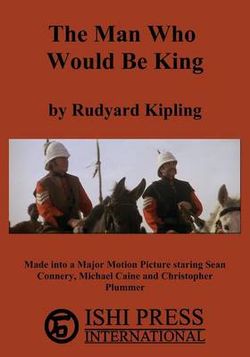

Made into a Major Motion Picture Staring Sean Connery, Michael Caine and Christopher Plummer
Paperback
Publication Date: 01/01/2016
This book, "The Man Who Would Be King" by Rudyard Kipling, was published in 1888 and in 1975 was made in to one of the all time greatest movies ever staring Sean Connery, who is best known for playing James Bond, Agent 007 in six James Bond movies including "From Russia With Love" and "Goldfinger." The co-stars were Michael Caine, best known for the title role in "Alfie," and Christopher Plummer who played Rudyard Kipling. The movie was nominated for four academy awards. It shows fantastic photography and scenery. The story starts with Rudyard Kipling working in a newspaper office, as he did for ten years in real life from 1882 to 1892. It must have been a daily experience for adventurers and beggars to come into Kipling's office with fantastic tales to tell. At the time that Rudyard Kipling wrote "The Man Who Would Be King" in 1888, Kafiristan was more of a fabled imaginary place as no European had ever been there and lived to tell about it. However, he must have realized that Kafirstan was a real place. A number of famous people had written about it, even though nobody had seen it. So Kipling wrote this make believe story about a place high in the mountains with fair-skinned women of incredible beauty, who worshiped pagan gods and were descended from soldiers of Alexander the Great. Kipling wrote "These women are whiter than you or me. . . . It's a mountainous country, and the women of those parts are very beautiful." At the time Kipling wrote this book in 1888, no European man had been to Kafirstan and lived to tell about it. The books "The Gilgit Game" and "Explorers of the Western Himalayas, 1820-95" by John Keay describes attempts by British adventurers to reach Kafirstan, but all had been killed. This was before the Durand Line had been drawn that separates Afghanistan from what is now Pakistan and divides Kafirstan into two parts, the Afghan side where the Red Kafirs lived but is now called Nuristan and the Pakistan side where the Black Kafirs still live in the Kalash valleys of Bumboret Birir and Rumbur. The first European man to reach Kafirstan and return alive was George Scott Robertson. It was not long thereafter when the British explorer, adventurer and army officer George Scott Robertson went there and returned with the report that the place was real. There are or were two kinds of Kafirs: Red and Black. The Red Kafirs were in Afghanistan but now they have converted to Islam so they are not Kafirs any more. The Black Kafirs are the Kalash, so named because their women wear black robes. There are several other instances where the movie was updated from the book to reflect the reality of Kafirstan. In the movie, there is a man and his wife from the village of Kamdesh where a wife is considered equal to a cow. Kamdesh is a real place in Nuristan. The real person Alexander the Great did marry a real woman named Roxanne, but she was from Balkh near Mazar-i-Sharif in Afghanistan, not from Nuristan. Chitralis do play polo and it is believed the game was invented there or in neighboring Gilgit, but they are not known to play the game with a human head as a ball.
- ISBN:
- 9784871875264
- 9784871875264
- Category:
- Historical Fiction
- Format:
- Paperback
- Publication Date:
- 01-01-2016
- Language:
- English
- Publisher:
- Ishi Press International
- Country of origin:
- United States
Click 'Notify Me' to get an email alert when this item becomes available
Great!
Click on Save to My Library / Lists
Click on Save to My Library / Lists
Select the List you'd like to categorise as, or add your own
Here you can mark if you have read this book, reading it or want to read
Awesome! You added your first item into your Library
Great! The fun begins.
Click on My Library / My Lists and I will take you there
Click on My Library / My Lists and I will take you there
Reviews
Be the first to review The Man Who Would Be King.


Share This Book: